A Study on the Economic Feasibility of Stand-Alone Microgrid for Carbon-Free Island in Korea
Abstract
1. Introduction
2. Literature Review
3. Methodology
3.1. Scenario Description
3.2. Data Assumption
4. Analysis Result
4.1. Scenario 1: Topology_A (Diesel-Only System)
4.2. Scenario 2: Topology_B (PV + WT + BESS System)
4.3. Scenario 3: Topology_C (PV-WT-BESS-P2H2P)
4.4. Capital Cost Forecast and Sensitivity Test
5. Conclusions
Author Contributions
Funding
Institutional Review Board Statement
Informed Consent Statement
Data Availability Statement
Conflicts of Interest
References
- UNFCCC. United Nations Framework Convention; UN: New York, NY, USA, 1992. [Google Scholar]
- UNFCCC. Republic of Korea First NDC; UN: New York, NY, USA, 2020; p. 3. [Google Scholar]
- Yang, J. Strategies for Low-Carbon Green Growth and Urban Management in Korea. J. Urban Manag. 2013, 2, 85–101. [Google Scholar] [CrossRef]
- Liu, Y.; Yu, S.; Zhu, Y.; Wang, D.; Liu, J. Modeling, planning, application and management of energy systems for isolated areas: A review. Renew. Sustain. Energy Rev. 2018, 82, 460–470. [Google Scholar] [CrossRef]
- Daeseak, C. A Study on the Construction of a Test-Bed for Demonstration of Microgrid in Island; Korea Electronics Technology Institute: Seongnam, Korea, 2016; Available online: https://www.dbpia.co.kr/Journal (accessed on 11 December 2020).
- Chae, U. Gasado Stand-alone Microgrid Establishment Case. Korean Inst. Electr. Eng. 2014, 12, 65–75. Available online: http://www.dbpia.co.kr/journal (accessed on 2 August 2020).
- Chang, J.-W.; Moon, H.-J.; Moon, S. Droop Control Method Considering Battery State of Charge(SOC) for Geocha-island Microgrid. Korean Inst. Electr. Eng. 2016. Available online: https://www.dbpia.co.kr/Journal (accessed on 3 August 2020).
- Choi, J.-H. Study on utilization of renewable energy in small scale energy independence island. Korean Inst. Electr. Eng. 2018, 871–872. Available online: http://www.dbpia.co.kr/journal (accessed on 20 September 2020).
- Rozlan, M.B.M.; Zobaa, A.F.; Abdel Aleem, S.H.E. The optimisation of stand-alone hybrid renewable energy systems using HOMER. Int. Rev. Electr. Eng. 2011, 6, 1802–1810. [Google Scholar]
- Jiménez, A.; Haase, S.G.; Mathur, S. Microgrid Analysis Tools Summary. Microgrid Anal. Tools Summ. 2018. [Google Scholar] [CrossRef]
- Chade, D.; Miklis, T.; Dvorak, D. Feasibility study of wind-to-hydrogen system for Arctic remote locations—Grimsey island case study. Renew. Energy 2015, 76, 204–211. [Google Scholar] [CrossRef]
- Kharel, S.; Shabani, B. Hydrogen as a Long-Term Large-Scale Energy Storage Solution to Support Renewables. Energies 2018, 11, 2825. [Google Scholar] [CrossRef]
- Ashourian, M.; Cherati, S.; Zin, A.M.; Niknam, N.; Mokhtar, A.; Anwari, M. Optimal green energy management for island resorts in Malaysia. Renew. Energy 2013, 51, 36–45. [Google Scholar] [CrossRef]
- Dawood, F.; Shafiullah, G.M.; Anda, M. Stand-Alone Microgrid with 100% Renewable Energy: A Case Study with Hy-brid Solar PV-Battery-Hydrogen. Sustainability 2020, 12, 2047. [Google Scholar] [CrossRef]
- Khadem, T.; Billah, S.B.; Barua, S.; Hossain, S. HOMER based hydrogen fuel cell system design for irrigation in Bangladesh. In Proceedings of the 2017 4th International Conference on Advances in Electrical Engineering (ICAEE), New York, NY, USA, 28–30 September 2017; pp. 445–449. [Google Scholar]
- Lidula, N.; Rajapakse, A. Microgrids research: A review of experimental microgrids and test systems. Renew. Sustain. Energy Rev. 2011, 15, 186–202. [Google Scholar] [CrossRef]
- Nassar, M.E.; Hamad, A.A.; Salama, M.M.A.; El-Saadany, E.F. A Novel Load Flow Algorithm for Islanded AC/DC Hybrid Microgrids. IEEE Trans. Smart Grid 2017, 10, 1553–1566. [Google Scholar] [CrossRef]
- Cataliotti, A.; Cosentino, V.; Di Cara, D.; Tine, G. LV Measurement Device Placement for Load Flow Analysis in MV Smart Grids. IEEE Trans. Instrum. Meas. 2016, 65, 999–1006. [Google Scholar] [CrossRef]
- Cataliotti, A.; Cosentino, V.; Di Cara, D.; Russotto, P.; Telaretti, E.; Tine, G. An Innovative Measurement Approach for Load Flow Analysis in MV Smart Grids. IEEE Trans. Smart Grid 2015, 7, 889–896. [Google Scholar] [CrossRef]
- Tostado-Véliz, M.; Kamel, S.; Jurado, F. A powerful power-flow method based on Composite Newton-Cotes formula for ill-conditioned power systems. Int. J. Electr. Power Energy Syst. 2020, 116, 105558. [Google Scholar] [CrossRef]
- Saldaña-González, A.E.; Sumper, A.; Aragüés-Peñalba, M.; Smolnikar, M. Advanced distribution measurement technologies and data applications for smart grids: A review. Energies 2020, 13, 3730. [Google Scholar] [CrossRef]
- Rinaldi, S.; Bonafini, F.; Ferrari, P.; Flammini, A.; Sisinni, E.; Di Cara, D.; Panzavecchia, N.; Tinè, G.; Cataliotti, A.; Cosentino, V.; et al. Characterization of IP-Based Communication for Smart Grid Using Software-Defined Networking. IEEE Trans. Instrum. Meas. 2018, 67, 2410–2419. [Google Scholar] [CrossRef]
- Kong, X.; Chen, Y.; Xu, T.; Wang, C.; Yong, C.; Li, P.; Yu, L. A Hybrid State Estimator Based on SCADA and PMU Measurements for Medium Voltage Distribution System. Appl. Sci. 2018, 8, 1527. [Google Scholar] [CrossRef]
- Huang, M.; Wei, Z.; Sun, G.; Zang, H. Hybrid State Estimation for Distribution Systems With AMI and SCADA Measurements. IEEE Access 2019, 7, 120350–120359. [Google Scholar] [CrossRef]
- Posada, A.F.P.; Villegas, J.G.; López-Lezama, J.M. A Scatter Search Heuristic for the Optimal Location, Sizing and Contract Pricing of Distributed Generation in Electric Distribution Systems. Energies 2017, 10, 1449. [Google Scholar] [CrossRef]
- Bayindir, R.; Colak, I.; Fulli, G.; Demirtas, K. Smart grid technologies and applications. Renew. Sustain. Energy Rev. 2016, 66, 499–516. [Google Scholar] [CrossRef]
- Lee, S.H. Optimization Study of Microgrid for Energy Self-sufficient Islands. Ph.D. Thesis, Sejong University, Seoul, Korea, 2018. Available online: https://scienceon.kisti.re.kr (accessed on 6 May 2020).
- Dubey, S.; Sarvaiya, J.N.; Seshadri, B. Temperature Dependent Photovoltaic (PV) Efficiency and Its Effect on PV Production in the World—A Review. Energy Procedia 2013, 33, 311–321. [Google Scholar] [CrossRef]
- IRENA. Renewable Power Generation Costs in 2019; IRENA: Abu Dhabi, UAE, 2020. [Google Scholar]
- Lockhart, E.; Li, X.; Booth, S.S.; Olis, D.R.; Salasovich, J.A.; Elsworth, J.; Lisell, L. Comparative Study of Techno-Economics of Lithium-Ion and Lead-Acid Batteries in Micro-Grids in Sub-Saharan Africa; Office of Scientific and Technical Information (OSTI): Washington, DC, USA, 2019. [Google Scholar]
- U.S. DOE. Energy Storage Technology and Cost Characterization Report; U.S. DOE: Washington, DC, USA, 2019. [Google Scholar]
- Møller, K.T.; Jensen, T.R.; Akiba, E.; Li, H.-W. Hydrogen—A sustainable energy carrier. Prog. Nat. Sci. 2017, 27, 34–40. [Google Scholar] [CrossRef]
- He, K.; Zhang, C.; He, Q.; Wu, Q.; Jackson, L.; Mao, L. Effectiveness of PEMFC historical state and operating mode in PEMFC prognosis. Int. J. Hydrog. Energy 2020, 45, 32355–32366. [Google Scholar] [CrossRef]
- Uzundurukan, A.; Bilgili, M.; Devrim, Y. Examination of Compression Effects on PEMFC Performance by Numerical and Experimental Analyses. Int. J. Hydrog. Energy 2020, 45, 35085–35096. [Google Scholar] [CrossRef]
- Zhou, Y.; Gu, A. Learning Curve Analysis of Wind Power and Photovoltaics Technology in US: Cost Reduction and the Importance of Research, Development and Demonstration. Sustainability 2019, 11, 2310. [Google Scholar] [CrossRef]
- Zauner, A.; Böhm, H.; Rosenfeld, D.C.; Tichler, R. Innovative large-scale energy storage technologies and Power-to-Gas concepts after optimization. In European Union’s Horizon 2020 Research and Innovation Programme; European Commission: Brussels, Belgium, 2016. [Google Scholar]
- Kwak Byung Sung. Future Development of Energy Technology: Cell and Related Technologies; Korea Institute of Energy Research: Daejeon, Korea, 2019. [Google Scholar]
- IRENA. Green Hydrogen Cost Reduction; IRENA: Abu Dhabi, UAE, 2019. [Google Scholar]
- Ministry of Trade, Industry and Energy. 9th Long-Term Electric Power Demand and Generation Plan; Ministry of Trade, Industry and Energy: Seoul, Korea, 2020.
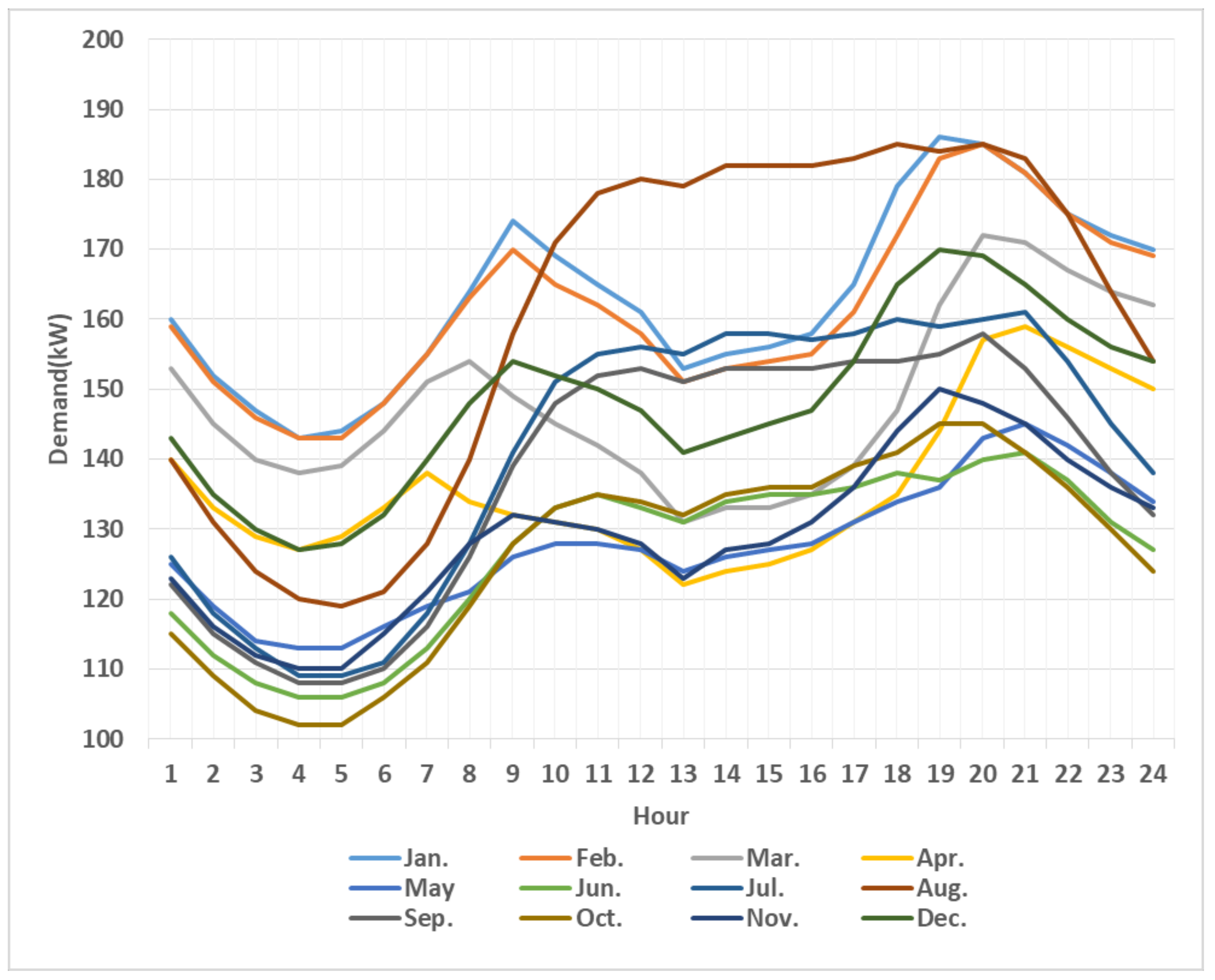
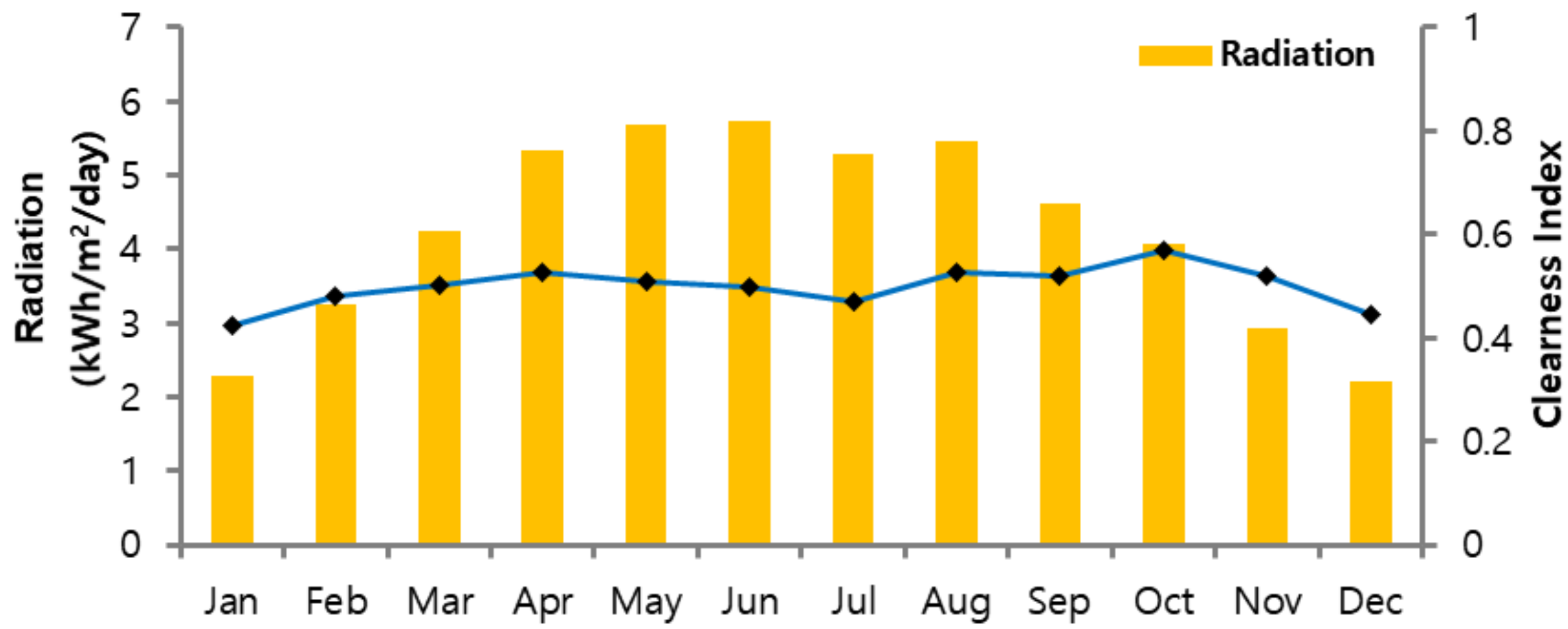


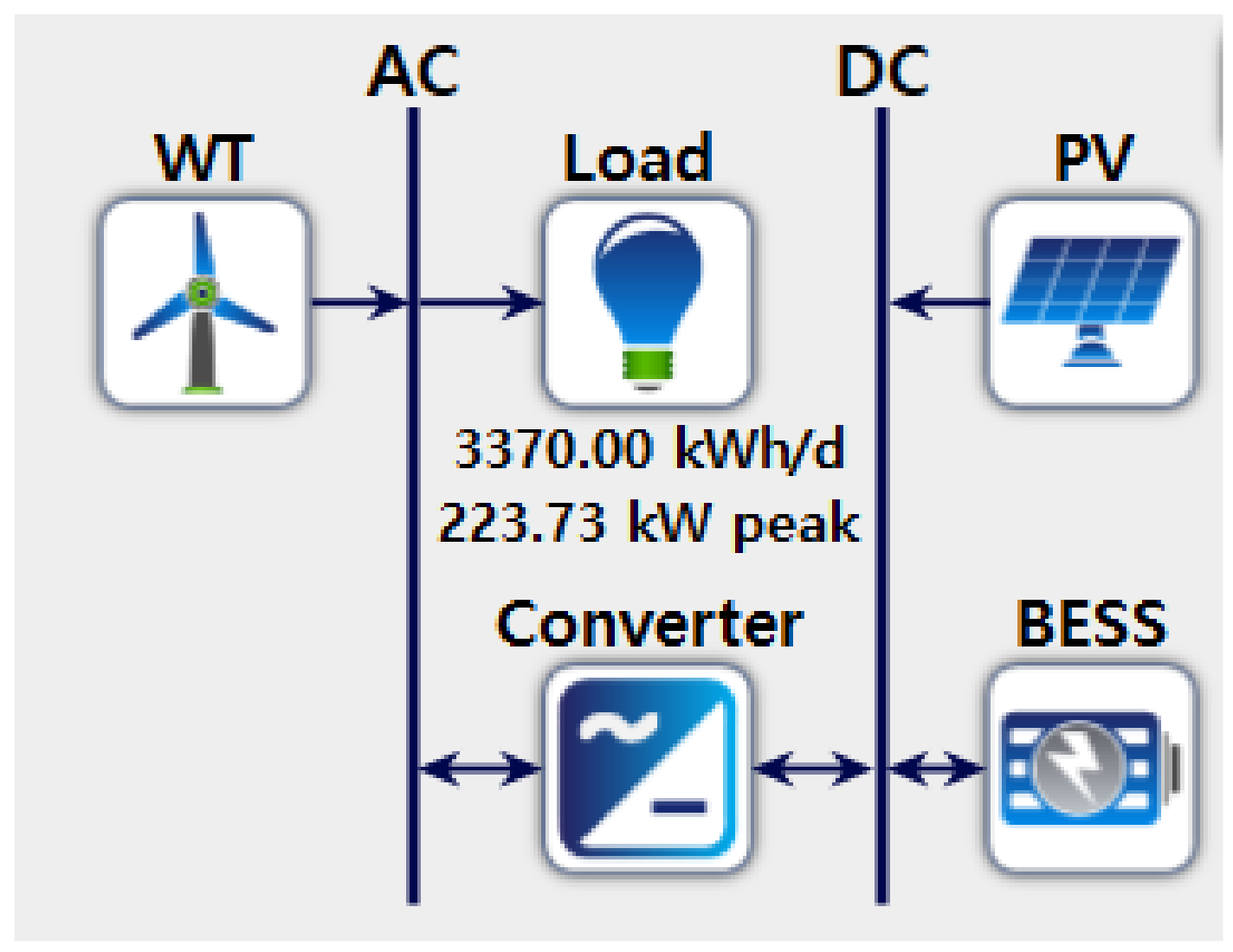
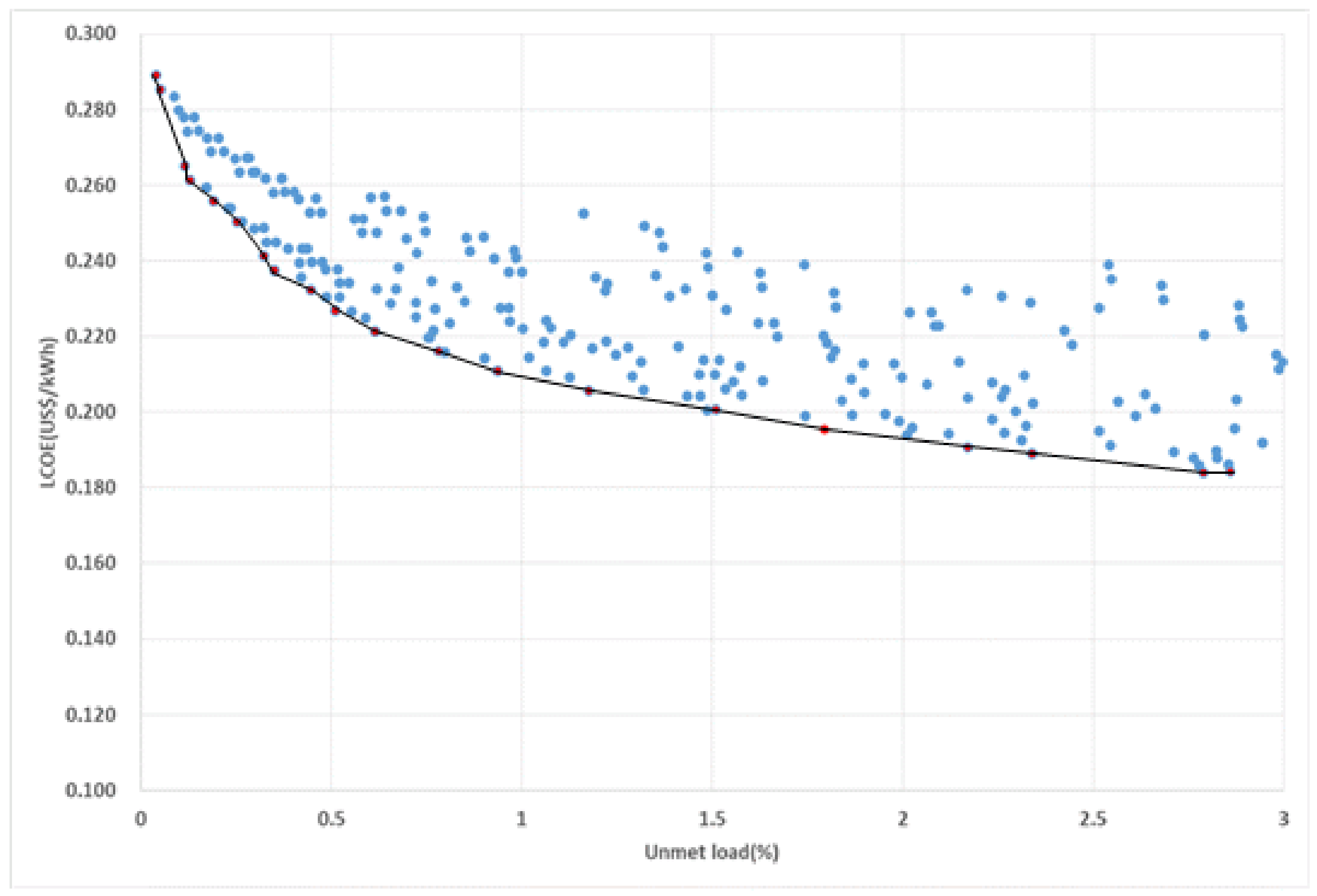
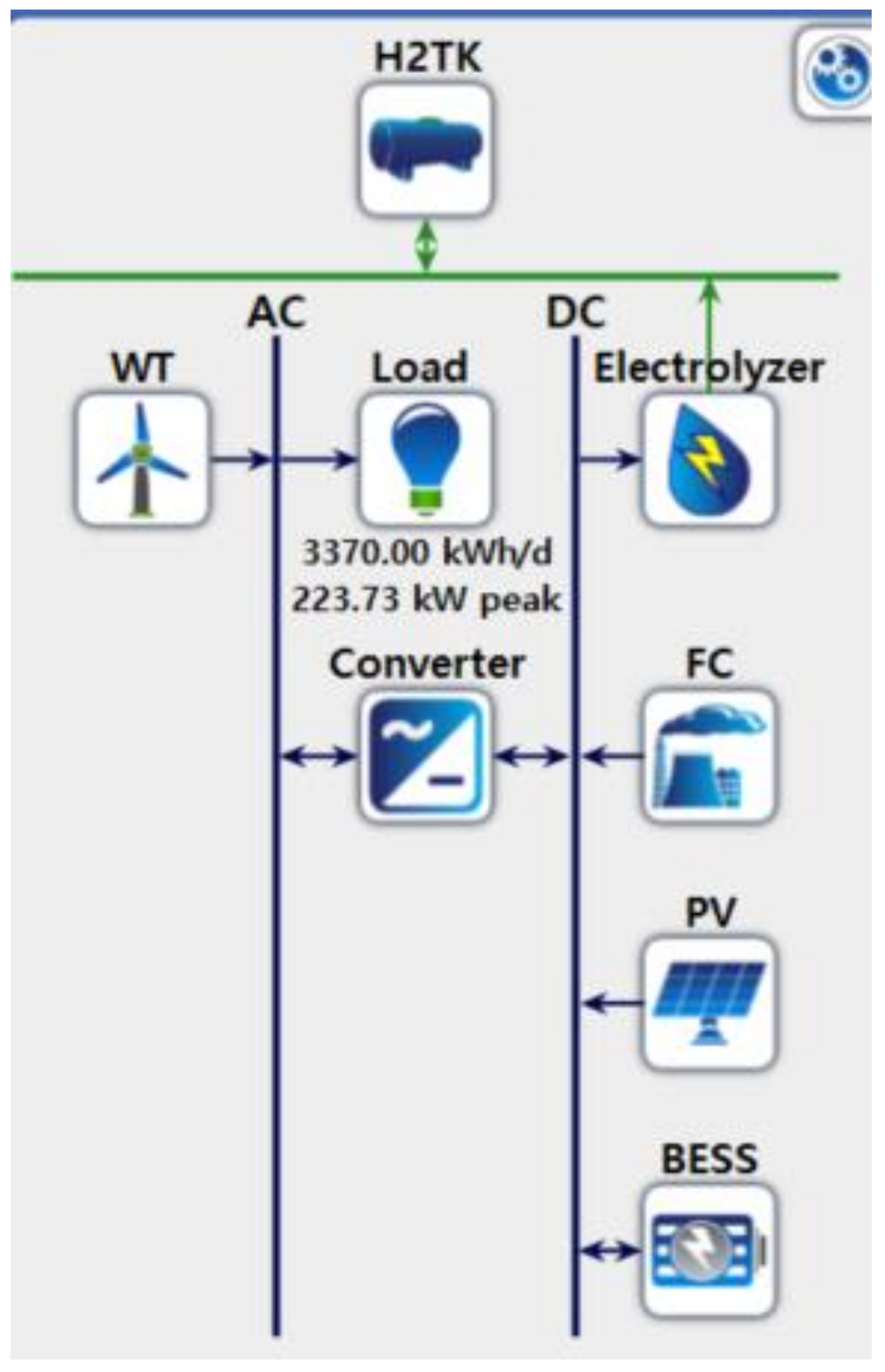

| Island | Gasado [6] | Geochado [7] | Sammado [8] | |
|---|---|---|---|---|
| Load | Max (kW) | 173 | 305 | 110 |
| Min (kW) | 61 | 80 | 45 | |
| DG (kW) | 100 | 150 | 80 | |
| PV (kW) | 314 | 111 | 122.4 | |
| WT (kW) | 100 | 100 | 3 | |
| BESS (kWh) | 3000 | 500 | 1231 | |
| Scenario | S1 | S2 | S3 |
|---|---|---|---|
| Topology | Topology_A (DG only) | Topology_B (PV-WT-Battery) | Topology_C( PV-WT-Battery-P2H2P) |
| Properties | Value | Properties | Value |
|---|---|---|---|
| Nominal voltage (V) | 48 | Max. charge current (A) | 200 |
| Nominal capacity (kWh) | 9.6 | Min. discharge current (A) | 500 |
| Round efficiency (%) | 90 | Series string size | 15 units |
| Component | Initial Capital Cost (USD/kW) | Replacement (USD/kW) | O&M Cost (USD/kW) | Lifetime (Year) |
|---|---|---|---|---|
| PV | 995 | 796 | 18.3 | 35 |
| Wind Turbine | 1473 | 1178 | 44.5 | 35 |
| BESS | 350 USD/kWh | 280 USD/kWh | 20 USD/kW-year | 10 |
| Converter | 600 | 300 | 3 USD/kW-year | 15 |
| Diesel Generator | 806 | 806 | 2 USD/op. hour | 55,000 h |
| Electrolyzer | 2500 | 2000 | 80 | 15 |
| HT | 1000 USD/kg | 800 USD/kg | 10 USD/year | 15 |
| Fuel Cell | 2500 | 2000 | 0.02 USD/op.hour | 60,000 h |
| Composition | Generation (kWh/year) | Unmet Load (kWh/year) | CO2 Emission (kg/year) | NPC (USD) | LCOE (USD/kWh) |
|---|---|---|---|---|---|
| DG 150 kW*2 | 1,228,443 | 1607 (0.13%) | 1,012,824 | 9,573,457 | 0.445 |
| DG 150 kW*3 | 130,050 | 0 | 1,016,237 | 9,696,931 | 0.450 |
| Capital | Replacement | O&M | Fuel | Salvage | Total |
|---|---|---|---|---|---|
| 242,000 | 415,443 | 2,148,944 | 6,787,252 | −20,182 | 9,573,457 |
| 2.5% | 4.3% | 22.4% | 70.9% | −0.2% | 100.0% |
| Component | Total Generation (kWh/year) | Hours of Operation (/year) | Capacity Factors (%) |
|---|---|---|---|
| DG1 | 973,432 | 8472 | 74.1 |
| DG2 | 255,011 | 5949 | 19.4 |
| Component | Optimal Capacity | Component | Optimal Capacity |
|---|---|---|---|
| PV | 700 kW | BESS | 2304 kWh |
| Wind Turbine | 250 kW*3unit | Converter | 200 kW |
| Component | Generation (kWh/year) | Unmet Load (kWh/year) | Excess Electricity (kWh/year) | CO2 Emission (kg/year) | NPC (USD) | LCOE (USD/kWh) |
|---|---|---|---|---|---|---|
| PV | 912,562 (32.6%) | 11,545 (0.939%) | 1,531,897 (54.6%) | 0 | 4,498,510 | 0.21 |
| WT | 1,892,983 (67.4%) | |||||
| Total | 2,805,545 (100%) |
| Initial Capital | Replacement | O&M | Fuel | Salvage | Total |
|---|---|---|---|---|---|
| 2,727,650 | 456,485 | 1,627,722 | 0 | −313,337 | 4,498,520 |
| 60.6% | 10.1% | 36.2% | 0% | −6.9% | 100% |
| PV | WT | BESS | Converter | Total |
|---|---|---|---|---|
| 843,903 | 1,567,405 | 1,927,542 | 159,670 | 4,498,520 |
| 18.8% | 34.8% | 42.8% | 3.5% | 100% |
| Component | Optimal Capacity | Component | Optimal Capacity |
|---|---|---|---|
| PV | 500 kW | H2TK | 200 kg |
| Wind Turbine | 250 kW*3unit | Electrolyzer | 200 kW |
| BESS | 288 kWh | Fuel Cell | 250 kW |
| Component | Generation (kWh/year) | Unmet Load (kWh/year) | Excess Electricity (kWh/year) | CO2 Emission (kg) | NPC (USD) | LCOE (USD/kWh) |
|---|---|---|---|---|---|---|
| WT | 1,892,983 (57.1%) | 14,148 (0.78%) | 944,421 (34%) | 0 | 4,429,553 | USD0.208/kWh |
| PV | 651,830 (41.3%) | |||||
| FC | 236,840 (1.6%) | |||||
| Total | 2,781,652 (100%) |
| Initial Capital | Replacement | O&M | Fuel | Salvage | Total |
|---|---|---|---|---|---|
| 3,148,050 | 453,584 | 1,172,999 | 0 | −345,080 | 4,429,553 |
| 71.1% | 10.2% | 26.5% | 0.0% | −7.82% | 100.0% |
| Component | Cost | Component | Cost | |
|---|---|---|---|---|
| WT | 1,567,404 (35.4%) | P2H2P | Electrolyzer | 974,821 (22.0%) |
| BESS | 240,942 (5.4%) | HT | 312,798 (7.1%) | |
| PV | 602,788 (13.6%) | Fuel Cell | 571,148 (12.9%) | |
| Converter | 159,670 (3.6%) | Sum | 1,858,767 (42%) | |
| Quantity | PV | WT | FC |
|---|---|---|---|
| Capacity Factor (%) | 14.8 | 28.8 | 10.8 |
| Hours of Operation | 4360 | 6668 | 1860 |
| Components | Capital Cost (Base Case: Table 4) | ||||
|---|---|---|---|---|---|
| Year of 2025 | Year of 2030 | ||||
| Forecasted Capital Cost | Ratio to Base Case | Forecasted Capital Cost | Ratio to Base Case | ||
| PV (USD/kW) | 806 | 81% | 657 | 66% | |
| Wind Turbine (USD/kW) | 1287 | 87.4% | 1141 | 77.5% | |
| BESS (USD/kWh) | 94 | 27% | 62 | 18% | |
| Converter (USD/kW) | 480 | 80% | 360 | 60% | |
| P2H2P | Electrolyzer (USD/kW) | 2000 | 80% | 1500 | 60% |
| HT (USD/kg) | 800 | 80% | 800 | 60% | |
| FC (USD/kW) | 1443 | 57.7% | 1090 | 43.6% | |
| Topology | Topology_B (PV + WT + BESS) | Topology_C (PV + WT + BESS + P2H2P) | ||
|---|---|---|---|---|
| Year | 2025 | 2030 | 2025 | 2030 |
| PV (kW) | 700 | 600 | 700 | 800 |
| WT (kW) | 250 kW*3 | 250 kW*4 | 250 kW*2 | 250 kW*2 |
| BESS (kWh) | 2880 | 2880 | 2304 | 2880 |
| Converter (kW) | 200 | 300 | 200 | 200 |
| Electrolyzer (kW) | 0 | 0 | 100 | 100 |
| HT (kg) | 0 | 0 | 100 | 100 |
| FC (kW) | 0 | 0 | 250 | 250 |
| Excess Elec (%) | 50.0 | 54.1 | 30.3 | 30.6 |
| Unmet Load (%) | 0.99 | 0.91 | 0.87 | 0.91 |
| LCOE (USD/kWh) | 0.121 | 0.105 | 0.128 | 0.100 |
Publisher’s Note: MDPI stays neutral with regard to jurisdictional claims in published maps and institutional affiliations. |
© 2021 by the authors. Licensee MDPI, Basel, Switzerland. This article is an open access article distributed under the terms and conditions of the Creative Commons Attribution (CC BY) license (https://creativecommons.org/licenses/by/4.0/).
Share and Cite
Mun, H.; Moon, B.; Park, S.; Yoon, Y. A Study on the Economic Feasibility of Stand-Alone Microgrid for Carbon-Free Island in Korea. Energies 2021, 14, 1913. https://doi.org/10.3390/en14071913
Mun H, Moon B, Park S, Yoon Y. A Study on the Economic Feasibility of Stand-Alone Microgrid for Carbon-Free Island in Korea. Energies. 2021; 14(7):1913. https://doi.org/10.3390/en14071913
Chicago/Turabian StyleMun, Hun, Byunghoon Moon, Soojin Park, and Yongbeum Yoon. 2021. "A Study on the Economic Feasibility of Stand-Alone Microgrid for Carbon-Free Island in Korea" Energies 14, no. 7: 1913. https://doi.org/10.3390/en14071913
APA StyleMun, H., Moon, B., Park, S., & Yoon, Y. (2021). A Study on the Economic Feasibility of Stand-Alone Microgrid for Carbon-Free Island in Korea. Energies, 14(7), 1913. https://doi.org/10.3390/en14071913





